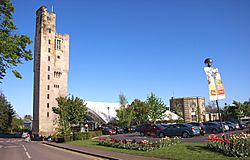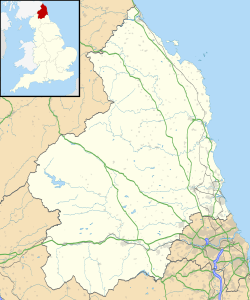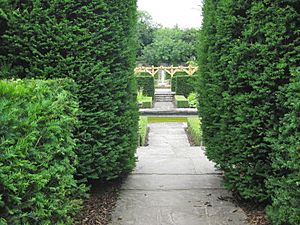Haggerston Castle facts for kids
Quick facts for kids Haggerston Castle |
|
|---|---|
| Northumberland, England | |

Haggerston Castle showing tower and Rotunda
|
|
|
Location in Northumberland
|
|
| Coordinates | 55°41′13″N 1°56′06″W / 55.687°N 1.935°W |
| Grid reference | NU042436 |
Haggerston Castle was once a grand castle in Northumberland, England. It was located near a village called Haggerston, about 5 miles (8 km) south of Berwick-upon-Tweed.
Today, only a few parts of the old castle remain. These include the main tower, a round building called the rotunda, and the stable block. These buildings are protected as Grade II listed buildings. Now, Haggerston Castle is part of a fun caravan park run by Haven Holidays.
Contents
The Story of Haggerston Castle
Haggerston Castle was first mentioned in history books in 1311. That year, Edward II, who was the King of England, actually visited the castle!
Later, in 1345, the castle was described as a "strong tower." The king at the time, Edward III, gave permission for the castle to add crenellations. These are the battlements with gaps that you often see on castle walls. They were used for defense.
Who Lived at Haggerston Castle?
The first family known to live at the castle were the de Hagardestons. People believe they came to England with William the Conqueror in the 11th century. His army traveled as far north as Berwick-upon-Tweed.
The land around Haggerston was quite wet and boggy back then. The lake you see there today is a leftover from those marshy times.
Sadly, many of the castle's old documents were lost in fires. Because of this, we don't know much about its very early history. We do know that John de Hagardeston lived there in the late 1100s and early 1200s. He passed away around 1210. His family later married into the Manners family from Cheswick, Northumberland. Over time, the family name changed from de Hagardeston to the more English-sounding Haggerston.
Changes in Ownership
In 1642, Sir Thomas Haggerston was given a special title. He became the first baronet of Haggerston. This was a title of honour from the King.
The Haggerston family grew richer and gained more land by marrying into other important families. In 1785, Sir Carnaby Haggerston owned the castle. His daughter, Mary, married Sir Thomas-Massey Stanley in 1805. The castle then passed to their family.
Later, around 1839, the castle changed hands again. It became owned by the Naylor/Leyland family. This happened because Sir William Thomas Stanley-Massey-Stanley, who owned it then, had many gambling debts.
Christopher John Leyland and the Gardens
By the 1880s, the castle and its lands were part of a large estate. This estate was built up by a banker from Liverpool named Thomas Naylor. When he died in 1891, his nephew, Christopher John Naylor, inherited Haggerston.
Christopher decided to move to Haggerston. He even changed his name to C.J. Leyland. By 1893, he had rebuilt the main house of the castle. He also started creating beautiful gardens on the huge 23,000-acre estate. He even designed a 1.4-acre Italian garden.
The Castle's Fires
There's an old local story that says a witch put a curse on Haggerston Castle. This curse supposedly caused destructive fires three times!
The reason for the curse and the date of the first fire are not known. However, there were big fires in 1618 and again in 1911. The last fire in 1911 was very damaging. It left only the tower and the rotunda standing. After this fire, C.J. Leyland never lived in the house he had rebuilt.
Haggerston Castle Today
C.J. Leyland passed away in 1926. In 1933, the family tried to get back some of their money. The ruined parts of the house he built were pulled down. The entire estate was then sold off in many small pieces.
Today, only the tower and the rotunda remain from the original castle. Both are protected as Grade II listed buildings. Haven Holidays now owns these buildings. They run a holiday park on the 256 acres of land around them.
The main building of the caravan park looks like a giant tent. It stretches between the old tower and rotunda. The tower is now used as a storeroom. The rotunda has become an "Activities and Leisure Fun-zone" for holidaymakers. The old cellars of the castle were once a bar called "The Tavern," but they are now closed.
Some other old buildings still stand. Seven semi-detached cottages, called "Roadside Cottages," are privately owned. There are also four "Flower Cottages." These were built in the late 1700s for the castle's workers. You can also find the ruins of the castle's chapel and its ice house. Across the A1 is the old dovecote, where pigeons were kept.
The Story of the Leylandii Tree
While Christopher Leyland was working on the gardens at Haggerston, something special happened. His brother, John, sent him six young trees. These trees were a new type of hybrid called Cupressocyparis × leylandii.
This special tree came about by accident in 1888. It happened at Leighton Hall, which was John Leyland's home. A female Nootka cypress flower was fertilized by pollen from a Monterey cypress. This created a new, unique tree!
In 1925, a company that grew trees was looking for a specific type of conifer. They needed a tree that grew fast and could survive in windy, salty places like Cornwall. They eventually found the six original trees that Leyland had grown. They started growing more of them. They called this new type "Haggerston Grey" to honor where they came from.
In 1953, a strong tornado blew down one of the original trees. After that, the Forestry Commission began developing more hybrids from the five trees that survived. Tree nurseries quickly saw how popular the "Leylandii" could become. Today, it is one of the most popular trees sold in garden centers across Great Britain!
Haggerston Castle Gallery
















